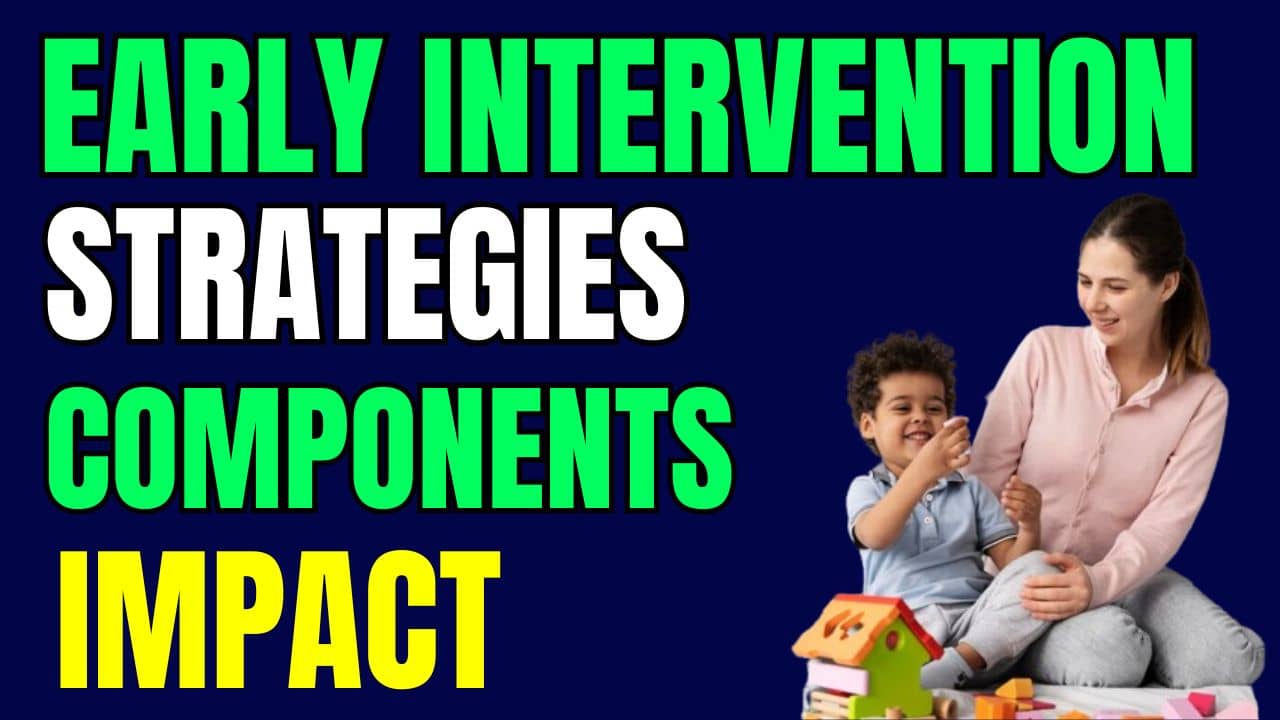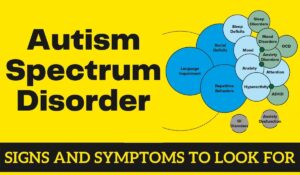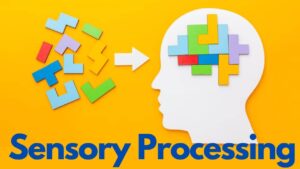Early intervention provides crucial support during the most formative years of a child’s development. These services can significantly impact a child’s trajectory, especially those facing developmental challenges or disabilities.
This blog post is your guide to early intervention. We’ll explore what it is, the key components that make it effective, and the profound impact it can have on children and their families. We’ll delve into practical strategies and resources to help you understand and advocate for early intervention services. Get ready to discover how this invaluable approach can empower children to reach their full potential.
Early Intervention Strategies
Early intervention is critical in supporting the development of children with Autism Spectrum Disorder (ASD). This chapter outlines effective strategies for parents to implement during the early stages of their child’s life, fostering optimal growth and addressing specific challenges associated with ASD.
1. Early Identification and Assessment:
- Early identification allows for timely intervention and support.
- Monitor developmental milestones and seek a professional assessment if concerns arise.
- Engage in routine developmental screenings with healthcare providers.
- Collaborate with early intervention specialists, including speech therapists, occupational therapists, and developmental psychologists.
2. Individualised Family-Centred Planning:
- Recognise the unique strengths and needs of your child and family.
- Work with professionals to develop an Individualised Family Service Plan (IFSP) or an Individualised Education Program (IEP) that outlines specific goals and interventions.
- Involve family members in the planning process to create a supportive home environment.
3. Speech and Language Interventions:
- Address communication challenges early to enhance language development.
- Engage in speech and language therapy tailored to your child’s needs.
- Use visual supports, augmentative and alternative communication (AAC) methods, and social stories to facilitate communication.
- Encourage expressive language through play and interactive activities.

4. Applied Behaviour Analysis (ABA):
- ABA is an evidence-based intervention focusing on behaviour modification.
- Collaborate with trained ABA therapists to implement structured behavioural interventions.
- Reinforce positive behaviours using rewards and positive reinforcement.
- Develop and follow a consistent routine to provide predictability.
5. Social Skills Development:
- Enhance social interactions and relationships.
- Facilitate social opportunities with peers through playdates and structured activities.
- Use visual supports, social stories, and role-playing to teach social skills.
- Model and encourage appropriate social behaviours in various contexts.

6. Sensory Integration
- Address sensory sensitivities to promote comfort and participation.
- Identify sensory triggers and create a sensory-friendly environment.
- Introduce sensory activities and tools, such as fidget toys or weighted blankets.
- Gradually expose your child to different sensory stimuli in a controlled manner.
7. Occupational Therapy:
- Enhance fine and gross motor skills, as well as activities of daily living.
- Collaborate with occupational therapists to develop targeted interventions.
- Use sensory-motor activities to improve coordination and body awareness.
- Implement visual schedules and routines to support daily tasks.
8. Early Education and Inclusion:
- Provide structured learning environments that foster socialisation and skill development.
- Explore early education programs that incorporate inclusive practices.
- Communicate regularly with teachers to ensure alignment between home and school strategies.
- Advocate for individualized support within the educational setting.
9. Parent Training and Support:
- Equip parents with the knowledge and skills to support their child’s development.
- Attend parent training sessions and workshops on ASD and related interventions.
- Connect with local support groups and online communities to share experiences and strategies.
- Prioritise self-care to maintain physical and emotional well-being.

10. Transition Planning:
- Plan for transitions between early intervention, school, and adulthood.
- Collaborate with educators to create smooth transitions between educational levels.
- Investigate post-school transition options and services for the future.
- Continuously assess and adjust intervention strategies as your child’s needs evolve.
Early intervention lays the foundation for a child’s developmental trajectory. By implementing these strategies, parents can create a nurturing and supportive environment that maximises their child’s potential and sets the stage for a fulfilling life. Regular collaboration with a team of professionals ensures a comprehensive and individualised approach to early intervention.
A. Impact of Early Intervention
Early intervention plays a crucial role in supporting children with Autism Spectrum Disorder (ASD) and can significantly impact their developmental outcomes. This chapter explores the Impact of early intervention and its far-reaching enefits for the child and their family.
1. Capitalising on Neuroplasticity:
- Early childhood is a period of heightened neuroplasticity, where the brain is highly adaptable and responsive to experiences.
- Early intervention during this critical period can shape neural pathways, promoting positive changes in cognitive, social, and communication skills.

2. Targeting Key Developmental Milestones:
- Early intervention addresses specific developmental milestones, such as language acquisition, social interaction, and motor skills.
- Targeting these milestones during the formative years helps establish a strong foundation for future learning and development.
3. Enhancing Social and Communication Skills:
- Social and communication challenges are core features of ASD.
- Early intervention interventions, such as speech therapy and social skills training, aim to improve communication abilities, foster social interactions, and lay the groundwork for meaningful relationships.
4. Mitigating the Impact of Sensory Sensitivities:
- Many individuals with ASD experience sensory sensitivities that can impact daily functioning.
- Early intervention strategies help individuals cope with sensory challenges, creating environments that minimise discomfort and promote sensory regulation.
5. Facilitating Inclusion in Educational Settings:
- Early intervention prepares children for successful inclusion in educational environments.
- Addressing academic and social skills early on enhances a child’s ability to participate meaningfully in mainstream educational settings, fostering a sense of belonging.

6. Reducing Challenging Behaviours:
- Challenging behaviours, such as meltdowns or repetitive actions, are common in ASD.
- Early intervention employs behaviour management techniques to address challenging behaviours, promoting emotional regulation and reducing stress for the child and their caregivers.
7. Empowering Families with
- Early intervention involves collaboration with families, providing them with tools and strategies to support their child’s development.
- Empowered and informed families play a pivotal role in implementing intervention strategies consistently, creating a supportive home environment.

8. Establishing Individualised Support Plans:
- Early intervention involves developing individualised support plans tailored to each child’s unique strengths and challenges.
- Individualised plans ensure that interventions are specifically designed to meet the child’s needs, optimising the effectiveness of the support provided.
9. Setting the Stage for Lifelong Learning:
- Early intervention lays the groundwork for a lifetime of learning and skill development.
- By addressing challenges early, children with ASD can develop the foundational skills necessary for ongoing education, vocational training, and independent living.
10. Promoting Positive Parent-Child Relationships:
- Early intervention encourages positive interactions between parents and children.
- Building strong parent-child relationships enhances communication, trust, and emotional connection, contributing to the family’s well-being.
11. Improving Long-Term Outcomes:
Early intervention has been linked to improved long-term outcomes for individuals with ASD.
By addressing challenges early, individuals are better equipped to navigate various life stages, increasing the likelihood of positive outcomes in education, employment, and social relationships.
Early intervention serves as a vital bridge, empowering children with special needs to navigate developmental challenges and reach their full potential. By embracing personalized interventions, collaborating with professionals, and celebrating every victory, we can foster a supportive environment where each child thrives. Remember, even small steps can make a world of difference. So, let’s unlock the power of early intervention and empower our children to blossom!





